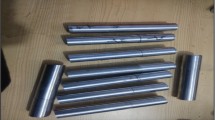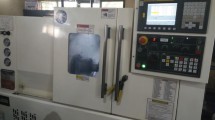Abstract
This article presents the application of Taguchi method and the utility concept for optimizing the machining parameters in turning of free-machining steel using a cemented carbide tool. A set of optimal process parameters, such as feed rate, cutting speed, and depth of cut on two multiple performance characteristics, namely, surface roughness and metal removal rate (MRR) is developed. The experiments were planned as per L9 orthogonal array. The optimal level of the process parameters was determined through the analysis of means (ANOM). The relative importance among the process parameters was identified through the analysis of variance (ANOVA). The ANOVA results indicated that the most significant process parameter is cutting speed followed by depth of cut that affect the optimization of multiple performance characteristics. The confirmation tests with optimal levels of machining parameters were carried out to illustrate the effectiveness of Taguchi optimization method. The optimization results revealed that a combination of higher levels of cutting speed and depth of cut along with feed rate in the medium level is essential in order to simultaneously minimize the surface roughness and to maximize the MRR.




Similar content being viewed by others
References
P.G. Benardos, G.C. Vosniakos, Predicting Surface Roughness in Machining: A Review, Int. J. Mach. Tools Manuf., 2003, 43, p 833–844
C.X.J. Feng, X. Wang, Development of Empirical Models for Surface Roughness Prediction in Finish Turning, Int. J. Adv. Manuf. Technol., 2002, 20, p 348–356
N.S. Reddy, P.V. Rao, Selection of Optimum Tool Geometry and Cutting Conditions Using a Surface Roughness Prediction Model for End Milling, Int. J. Adv. Manuf. Technol., 2005, 26, p 1202–1210
C.Y. Nian, W.H. Yang, Y.S. Tarng, Optimization of Turning Operations with Multiple Performance Characteristics, J. Mater. Process. Technol., 1999, 95, p 90–96
M.S. Phadke, Quality Engineering Using Robust Design, Prentice Hall, New Jersey, 1989
P.J. Ross, Taguchi Techniques for Quality Engineering, McGraw-Hill, New York, 1996
W.H. Yang, Y.S. Tarng, Design Optimization of Cutting Parameters for Turning Operations Based on the Taguchi Method, J. Mater. Process. Technol., 1998, 84, p 122–129
J.L. Yang, J.C. Chen, A Systematic Approach for Identifying Optimum Surface Roughness Performance in End Milling Operations, J. Ind. Technol., 2001, 17, p 1–8
C.S. Deng, J.H. Chin, Hole Roundness in Deep Hole Drilling as Analysed by Taguchi Methods, Int. J. Adv. Manuf. Technol., 2005, 25, p 420–426
R. Jeyapaul, P. Shahabudeen, K. Krishnaiah, Quality Management Research by Considering Multi-Response Problems in the Taguchi Method—A Review, Int. J. Adv. Manuf. Technol., 2005, 26, p 1331–1337
J.P. Davim, A Note on the Determination of Optimal Cutting Conditions for Surface Finish Obtained in Turning Using Design of Experiments, J. Mater. Process Technol. 2001, 116, p 305–308
P. Kumar, P.B. Barua, J.L. Gaindhar, Quality Optimization (Multi-Characteristic) Through Taguchi’s Technique and Utility Concept, Qual. Reliab. Eng. Int., 2000, 16, p 475–485
Minitab Inc., Minitab User Manual Version 13, Quality Plaza, 1829 Pine Hall Road, State College, PA, 16801-3008, 2006
N. Tosun, L. Ozler, Optimisation for Hot Turning Operations with Multiple Performance Characteristics, Int. J. Adv. Manuf. Technol., 2004, 23, p 777–782
T. Ozel, T. Hsu, E. Zeren, Effects of Cutting Edge Geometry, Workpiece Hardness, Feed Rate and Cutting Speed on Surface Roughness and Forces in Finish Turning of Hardened AISI H13 Steel, Int. J. Adv. Manuf. Technol., 2005, 25, p 262–269
D. Singh, P. Rao, A Surface Roughness Prediction Model for Hard Turning Process, Int. J. Adv. Manuf. Technol., 2007, 32, p 1115–1124
Author information
Authors and Affiliations
Corresponding author
Rights and permissions
About this article
Cite this article
Gaitonde, V., Karnik, S. & Davim, J.P. Multiperformance Optimization in Turning of Free-Machining Steel Using Taguchi Method and Utility Concept. J. of Materi Eng and Perform 18, 231–236 (2009). https://doi.org/10.1007/s11665-008-9269-6
Received:
Revised:
Accepted:
Published:
Issue Date:
DOI: https://doi.org/10.1007/s11665-008-9269-6




